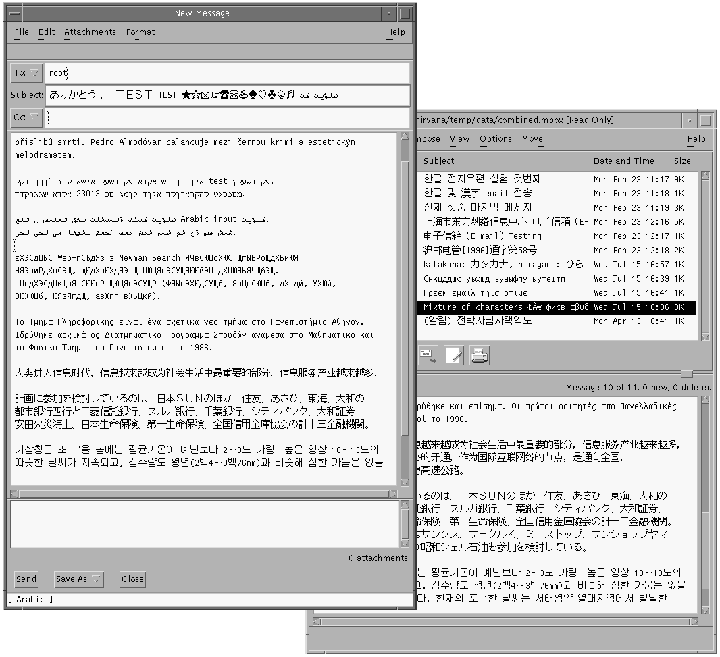This support supports users to view virtually any kind of email encoded in various character sets from any region of the world in a single instance of DtMail. DtMail decodes received email by looking at the MIME charset and content transfer encoding provided with the email. Windows-125x MIME charsets are supported.
For sending email, you need to specify a MIME charset that is understood by the recipient mail user agent (mail client), or you can use the default MIME charset provided by the en_US.UTF-8 locale. You can switch the character set of outgoing email, in the New Message window, press Control Y, or click the Format menu button and then click the Change Char Set button. The next available character set name displays in the bottom left corner at the top of the Send button.
If your email message header or message body contains characters that cannot be represented by the MIME charset specified, the system automatically switches the charset to UTF-8 which can represent any character.
If your message contains characters from the 7-bit US-ASCII character set only, the default MIME charset of your email is US-ASCII. Any mail user agent can interpret such email messages without loss of characters or information.
If your message contains characters from a mixture of scripts, the default MIME charset is UTF-8. Any 8-bit characters of UTF-8 are encoded with Quoted-Printable encoding. For more details on MIME, registered MIME charsets, and Quoted-Printable encoding, refer to RFCs 2045, 2046, 2047, 2048, 2049, 2279, 2152, 2237, 1922, 1557, 1555, and 1489.
Figure 5-12 DtMail New Message Window

Programming Environment
Internationalized applications should automatically enable the en_US.UTF-8 locale. However, proper FontSet/XmFontList definitions in the application's resource file are required.
For information on internationalized applications, see Creating Worldwide Software: Solaris International Developer's Guide, 2nd edition.
FontSet Used with X Applications
For information about the FontSet used with X applications, please see "Unicode Locale: en_US.UTF-8 Support Overview".
Because the Solaris 9 environment supports the CDE desktop environment, each character set has a guaranteed set of fonts.
The following is a list of the Latin-1 fonts that are supported in the Solaris 9 product:
-dt-interface system-medium-r-normal-xxs sans utf-10-100-72-72-p-59-iso8859-1 -dt-interface system-medium-r-normal-xs sans utf-12-120-72-72-p-71-iso8859-1 -dt-interface system-medium-r-normal-s sans utf-14-140-72-72-p-82-iso8859-1 -dt-interface system-medium-r-normal-m sans utf-17-170-72-72-p-97-iso8859-1 -dt-interface system-medium-r-normal-l sans utf-18-180-72-72-p-106-iso8859-1 -dt-interface system-medium-r-normal-xl sans utf-20-200-72-72-p-114-iso8859-1 -dt-interface system-medium-r-normal-xxl sans utf-24-240-72-72-p-137-iso8859-1 |
For information on CDE common font aliases, including -dt-interface user-* and -dt-application-* aliases, see Common Desktop Environment: Internationalization Programmer's Guide.
In the en_US.UTF-8 locale, utf is also included in the locale's common font aliases as an additional attribute in the style field of the X logical font description name. Therefore, to have a proper set of fonts, the additional style has to be included in the font set creation as in the following example:
fs = XCreateFontSet(display, "-dt-interface system-medium-r-normal-s*utf*", &missing_ptr, &missing_count, &def_string); |
FontList Definition in CDE/Motif Applications
As with FontSet definition, the XmFontList resource definition of an application should also include the additional style attribute supported by the locale.
*fontList:\ -dt-interface system-medium-r-normal-s*utf*: |




